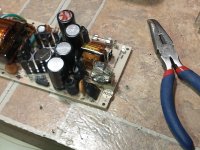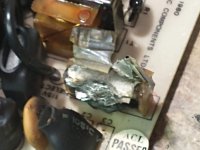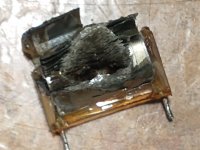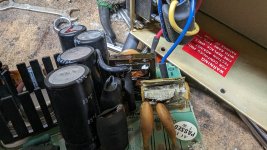Upcoming Events:
- VCF South West - June 14 - 16, Davidson-Gundy Alumni Center at University of Texas at Dallas
- VCF West - Aug 2 - 3, Computer History Museum, Mountain View, CA
- VCF Midwest - Sept 7 - 8 2024, Schaumburg, IL
- VCF SoCal - Mid February 2025, Location TBD, Southern CA
- VCF East - April 2025, Infoage Museum, Wall NJ
-
Please review our updated Terms and Rules here
You are using an out of date browser. It may not display this or other websites correctly.
You should upgrade or use an alternative browser.
You should upgrade or use an alternative browser.
Another Rifa goes out in a blaze of glory
- Thread starter TMA-1
- Start date
NeXT
Veteran Member
With those things, peace was never an option.
daver2
10k Member
Hmmmm, bacon...
Dave
Dave
Chuck(G)
25k Member
A little glue and a new coat of paint and she'll be as good as new... 
T-Squared
Veteran Member
I don't see the problem that you're talking about. Can you zoom in a bit closer? [/s]
Chuck(G)
25k Member
I wish that I'd have taken a photo of the Sprague "Vitamin Q" steel-jacketed paper-in-oil hermetically sealed cap that decided to embed shrapnel in my ceiling when it blew. The old mil-spec Vitamin Qs are still somewhat popular in the retro-tube-sound clan.
TMA-1
Experienced Member
Ha ha ha,... worthy replies, all.
I just wish all electronic repairs were that easy. When a mechanic finds the broken part, he can usually SEE that it's deficient. Not usually true in our world. (This was an obvious exception.)
I just wish all electronic repairs were that easy. When a mechanic finds the broken part, he can usually SEE that it's deficient. Not usually true in our world. (This was an obvious exception.)
tech58761
Experienced Member
Hmmm... now where did I put my box of "blaze of glory" parts...?
offensive_Jerk
Veteran Member
Chuck(G)
25k Member
Here's something that I've wondered about. I have a big container of varying values (from pF to µF) of these paper-in-oil-clear-encapsulation capacitors. The encapsulation on many are yellow-ish to not-quite-amber and others which are perfectly colorless. Is there any practical durability difference between the two?
Hugo Holden
Veteran Member
Part of the pathology of the Rifa cap is the nature of the plastic package. Another part is degradation of the film, where the metallic film on the paper is eaten away and they lose capacity over time. It might be some of the vapor from this process that expands the initial volume and starts to encourage the cracking of the plastic.
The plastic initially gets multiple fine cracks. This starts to let in air and water vapor. This is absorbed by the paper. Long before they smoke, they start to get volume expansion and swell up. This significantly opens the cracks and it is a positive feedback effect. Once they are swollen enough and the paper contains enough water they start to electrically conduct, presumably due to residual salts in the paper or salt products derived from the vaporized metal film creating a weak electrolyte, then they start to heat and burn up. In some cases you will see the manufacturer was aware of this and put a low wattage low Ohm value carbon resistor is series that will act as a kind of fuse when the capacitor starts to conduct heavily.
Descriptive terms applied to the Rifa include safety capacitor, fire resistant, self healing and other overly optimistic descriptors. They should never be used as spark suppressors across switch contacts in series with motors or industrial machinery (they often are) they can spontaneously short out starting the machine. I have told a story once how I was sleeping in a room with a Singer Sewing machine, the Rifa cap across the control pedal shorted out and the machine started at full speed in the middle of the night.
It is a combination of the paper dielectric and the type of plastic casing that causes the trouble.
On the other hand, capacitors using paper dielectric and a solid foil, immersed in oil, like the typical PIO capacitor in metal canister, doesn't have these issues and could be called fire proof too because of the metal encapsulation. But for the same uF value and AC & DC voltage rating, these are much bigger than a Rifa. This is the price to pay when you put miniaturization in front of reliability and safety.
The plastic initially gets multiple fine cracks. This starts to let in air and water vapor. This is absorbed by the paper. Long before they smoke, they start to get volume expansion and swell up. This significantly opens the cracks and it is a positive feedback effect. Once they are swollen enough and the paper contains enough water they start to electrically conduct, presumably due to residual salts in the paper or salt products derived from the vaporized metal film creating a weak electrolyte, then they start to heat and burn up. In some cases you will see the manufacturer was aware of this and put a low wattage low Ohm value carbon resistor is series that will act as a kind of fuse when the capacitor starts to conduct heavily.
Descriptive terms applied to the Rifa include safety capacitor, fire resistant, self healing and other overly optimistic descriptors. They should never be used as spark suppressors across switch contacts in series with motors or industrial machinery (they often are) they can spontaneously short out starting the machine. I have told a story once how I was sleeping in a room with a Singer Sewing machine, the Rifa cap across the control pedal shorted out and the machine started at full speed in the middle of the night.
It is a combination of the paper dielectric and the type of plastic casing that causes the trouble.
On the other hand, capacitors using paper dielectric and a solid foil, immersed in oil, like the typical PIO capacitor in metal canister, doesn't have these issues and could be called fire proof too because of the metal encapsulation. But for the same uF value and AC & DC voltage rating, these are much bigger than a Rifa. This is the price to pay when you put miniaturization in front of reliability and safety.
mark0x01
Experienced Member
It certainly isn't from degridation due to use, as I have new "old stock" 1980's PSU's where the caps have developed large cracks.
offensive_Jerk
Veteran Member
Kind of funny, I just got that Apple in the mail today and was going to immediately replace the rifa, but was too anxious to power test the machine. I got side tracked with the intermittent keyboard, then I heard the dreaded noise. I grabbed the computer and ran outside. When those blow, they kind of smell like rotten seafood to me. The smell sticks to whatever was next to the rifa.
I didn't think the rifa would blow so quickly, considering the seller had powered it up.
I didn't think the rifa would blow so quickly, considering the seller had powered it up.
radventure
Member
- Joined
- May 26, 2022
- Messages
- 42
My IIe had obviously been left with blown Rifa's, it still worked and had obviously been used for quite a while after "the Rifa-ning" because every component and surface in that half of the PSU was covered in nasty caramel residue, splatters through almost every part of the other half..... that took some work to clean!!
VERAULT
Veteran Member
The iie's I picked up at the last swapmeet (still no swapmeet scheduled for next year at all huh?! WHY?) in october all had blown rifa caps and all seemed to have been blown years ago. Machines still worked fine, just as t mentioned some cotton swabs and rubbing alcohol was needed to remove the dirty glazing.
I dont know about the rest of you but I have bags of X and Y suppression caps because this is just part for the course.
I dont know about the rest of you but I have bags of X and Y suppression caps because this is just part for the course.




